What you should know about Sevilla as first-time visitor
Prepare to be blown away by this stunning city. Without exaggeration, the beautiful capital of Andalucía is a place everybody must see at least once!
The city’s origins go back to the 8th century BC which makes Sevilla one of the oldest cities in Spain. It flourished as a Roman marketplace, was occupied by Silingi vandals, the Visigoths and in 712 Abd al-Aziz ibn Mussa conquered the city and changed its name from the historic ‘Hispalis’ to the Arabic name ‘Isbiliyya’. The city then came under the rules of by the Almoravids, and shortly after the Almohads. This was the time Sevilla became one of the most important in Spain and many of the remaining historic monuments can be traced back to this period, even though they might not exist anymore in their original state. In 1248, Sevilla was conquered by King Ferdinand III of Castile who turned it into one of the capitals of his kingdom and from then on continued to grow and add many more amazing monuments and customs under Christian rule.
When is the best time to visit Sevilla
If you do not mind scorching hot and humid summer days, Sevilla could be considered a year-round destination.
That said, I recommend visiting either spring or late autumn. From March to early May, temperatures will be still fairly mild albeit in May they might start to hit the high 20°C already. Spring is also the time when the city will be filled with the sweet scents of orange blossoms and jasmine.
In addition to this, there are two major events happing in spring. Semana Santa, the Holy Week proceeding Easter Sunday is one of the main festivals taking place in Spain. During the whole week there are various parades involving the various brotherhoods of local churches and whilst this is mostly a religious event, but you will find families celebrating in restaurants and bars having a lot of fun. Meanwhile, Feria de Abril is a large spring festival celebrated each year two weeks after the Easter weekend and there is even more movement in the city. Streets will be adorned with beautiful flower compositions and there’s music everywhere.
For sure, the city is even more crowed during the two spring events but if you don’t mind large groups of people, then it’s definitely worthwhile to plan your trip around either Semana Santa or Feria de Abril.
Another good time to visit is from mid-end September to early November, when temperatures are starting to drop.
How many days should you plan for a visit to Sevilla
From the stunning historic monuments, lively squares, museums, art galleries, enthralling flamenco dances, and the amazing culinary scene, Sevilla today offers so much to see and do that you could fill at least two weeks without running short of new, amazing experiences.
However, Sevilla is mainly a destination you will consider for a city trip, and this would typically involve a stay of two to three nights. Which means, you have three to four days to explore the city and this is about the time you need to get a good impression of Sevilla’s major locations.
Where to stay in Sevilla
There is no shortage of hotels, Airbnb’s, and hostels across the whole city offering accommodation from basic overnight stays to top-notch luxury in Sevilla.
If you are looking for the latter, among the city’s leading luxury hotels the one that will always by my first choice is legendary Hotel Alfonso XIII. Build by order of King Alfonso XIII in occasion of the 1929 Ibero-American Exhibition which took place at Sevilla, the hotel today is part of the Luxury Collection and an iconic sight of Sevilla itself.

Featured both in the famous 1962 movie Lawrence of Arabia, starring among other Peter O’Toole, Alec Guinness, Anthony Quinn, and Omar Sharif, and the more recent Netflix series The Crown, the hotel might actually look quite familiar when you check it out.
If you want to learn more about the hotel, read my post Royal Luxury at Hotel Alfonso XIII.
Other excellent five-star hotels located within the historic part of the city include the EME Catedral just opposite the cathedral and Hotel Palacio de Villapanes, part of the Small Luxury Hotels of the World collection.
What to do and see in Sevilla on a two-to-three-day itinerary
When visiting Sevilla for the first time, there are a couple of places that you certainly must see. Even though they are likely the most crowded by tourists. On the other hand, there are also a couple of places you might be able to enjoy with less of a crowd. Especially if you make a point to come early.
Read on to find out which place you should not miss during a trip to beautiful Sevilla.
Plaza de España
Built for the Ibero-American exhibition in 1929, Plaza de España is one of the places most likely recognized the world over – even by those who have never visited in person. The impressive Mudejar-style building in the centre surrounded by canals and gardens has appeared in movies such as Lawrence of Arabia and even Star Wars.
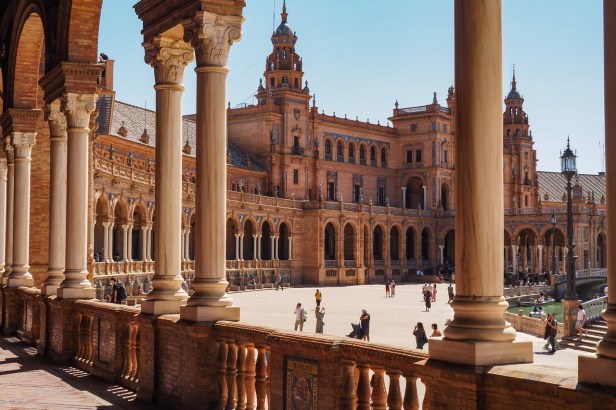
In real live, the huge square is as impressive and stunning as you might expect. Designed by Aníbal González in Spanish Renaissance style, Plaza de España is the beating heart and soul of Maria Luisa Park of which it forms part.

The amazing buildings lining the square in a semi-circle today are mostly used as government offices. At the foot of the buildings are 52 benches adorned with the typical colourful tiles (azulejos) of Sevilla along with frescos depicting the 52 different provinces of Spain.

If you want to hire one of the boots and sail through the canals spanning the square, I suggest coming here early morning as the lines at the boat hire are getting longer during the day. While it’s only a short distance, floating along the canal and passing under the many bridges is a lot of fun and offers a different perspective admiring the square and its buildings.
Maria Luisa Park
While most visitors will know about and flock to Plaza de España not all are aware the impressive square is part of Maria Luisa Park-the largest green area in Sevilla and home to more impressive architecture and beautiful gardens.
Originally part of the gardens of Palacio de San Telmo, in 1893 Princes Maria Luisa donated the garden to the city of Sevilla with the aim to create a public park.
Redesigned by French landscape architect Nicolas Forestier and Spanish architect Aníbal González, Maria Luisa Park is now home to several beautiful pavilions, including the pavilions of the United States, Argentina, Mexico, Guatemala, Colombia, and Brazil.

The most impressive building at Maria Luisa Park is located at Plaza de América, right at the other end of the park from Plaza de España. Mudéjar Pavilion is home to Museo de Artes y Costumbres Populares (the museum for ethnology).
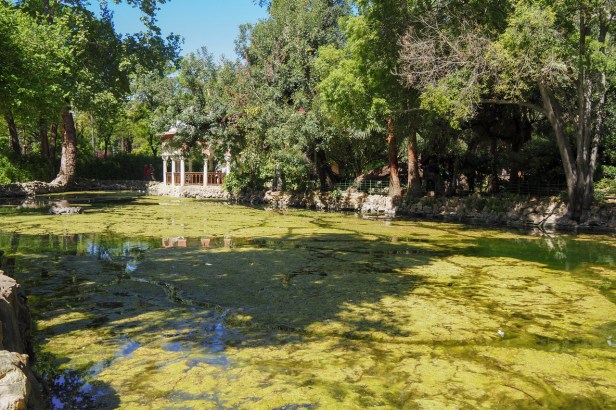
Across the park, there are various fountains, a gorgeous small waterlily pool as well as lots of benches and green spaces. Wandering through the park, it becomes quite evident why it’s so highly popular with locals who come here to sit down in the gardens and on the lawns, often including a picnic under the trees.
Real (Royal) Alcázar de Sevilla
A place that most likely does not need much introduction. If you are planning a trip to Sevilla, you will definitely be aware of this beautiful gem.

Looking back at a rich history with many changes, extensions and remodelling taking place over the centuries since Real Alcazar was first mentioned in the 8th century when a fortress was built by the first Moorish rulers of the area. In the centuries that followed, more buildings were added to the premisses, while over time several were also demolished and re-build.

Today, the impressive complex is a mixture of styles with the beautiful Mudehar style taking the lead. Meanwhile, the large curated garden area is one of the most inviting green areas of the city. It features various water ponds and fountains, along with approximately 20,000 trees and plants that belong to around 187 different species.
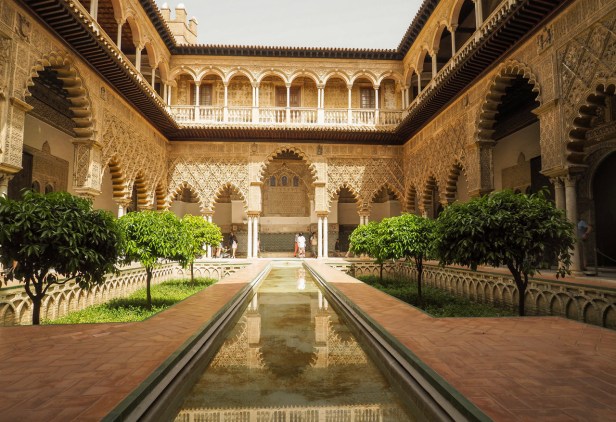
An UNESCO World Heritage Site since 1987, Real Alcázar is one of the oldest palaces in Europe still in use. The upper floor of the palace is still inhabited by the Spanish royal family when they come to visit Sevilla.
Check out my post Real Alcázar de Sevilla: What to know before your visit Sevilla’s top attraction for more insight and lots of more photos of this amazing place.
Sevilla Cathedral
Officially called Catedral de Santa Maria de la Sede, the stunning 15th century cathedral is the third largest church in the world, with only St. Peter’s Basilica in Rome and St. Paul’s Cathedral in London being bigger. Together with Real Alcázar, it has been an UNESCO World Heritage Site since 1987.

The cathedral was built between 1403 and 1507 on the former site of the first Mosque of Sevilla. Today only the beautiful orange court (Patio de lo Naranjos) and the bell tower remain from the original building, which was demolished after the city was conquered by Christian King Ferdinand
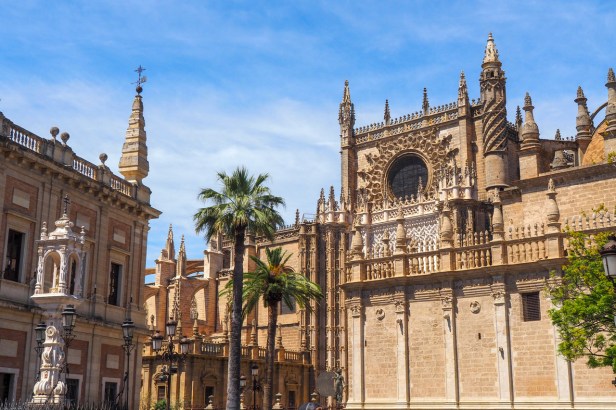
Inside the cathedral you will find the mausoleum of Christopher Columbus, albeit there remain rumours his body might not be buried there after all.
Giralda Tower
Visible from nearly everywhere across the city, the beautiful Giralda tower was originally built as the minaret of the old mosque. The lower part of the structure is still part of the original building while the top of the former minaret was destroyed in an earthquake in the mid-14th century. It was first replaced by a smaller belltower and in the 16th century the current Renaissance style belltower was built, and the weathervane located at the top of tower known as the Giraldillo was added.
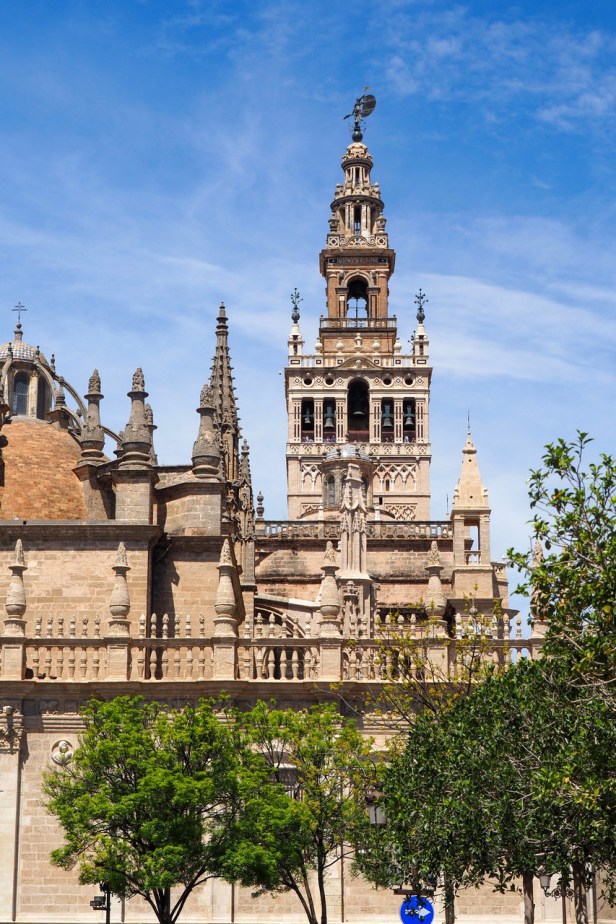
For over 800 years, at 103 metres high the Giralda tower was the tallest building of Sevilla, and it still offers a stunning panoramic view over the city.
Plaza del Cabildo
You only need to cross Avenida de la Constitución in front of the cathedral and step through a small archway to reach one of the most beautiful and perhaps quietest locations of historic Sevilla.
The site once housed the college of San Miguel, owned by the Cabildo of the Cathedral (and hence the name). The college was demolished in the mid-20th century and replaces with the gorgeous small semi-circular plaza.

Plaza del Cabildo is lined by a series of arches featuring beautiful frescoes by Sevillian painter José Palomar. There are a couple of specialist shops and restaurants inviting to spend some time here. If you come on a Sunday morning, you can also explore a small flea market with collectors items such as coins, small antiques, postcards, and minerals amongst others.
Exploring the small winding streets of Barrio de Santa Cruz
The oldest part of Sevilla, the area around Real Alcázar and the Cathedral of Sevilla is located at the southern-most corner of the Casco Antigüo. It is undoubtedly the most touristy area of the city, but the quarter is still a lively residential neighbourhood too which is adding a lot to its unique charm.

The origins of Barrio de Santa Cruz go back to Roman times while today it is mostly known as the former Jewish quarter of Sevilla following the conquest of the city by King Ferdinand III of Castille in 1248.
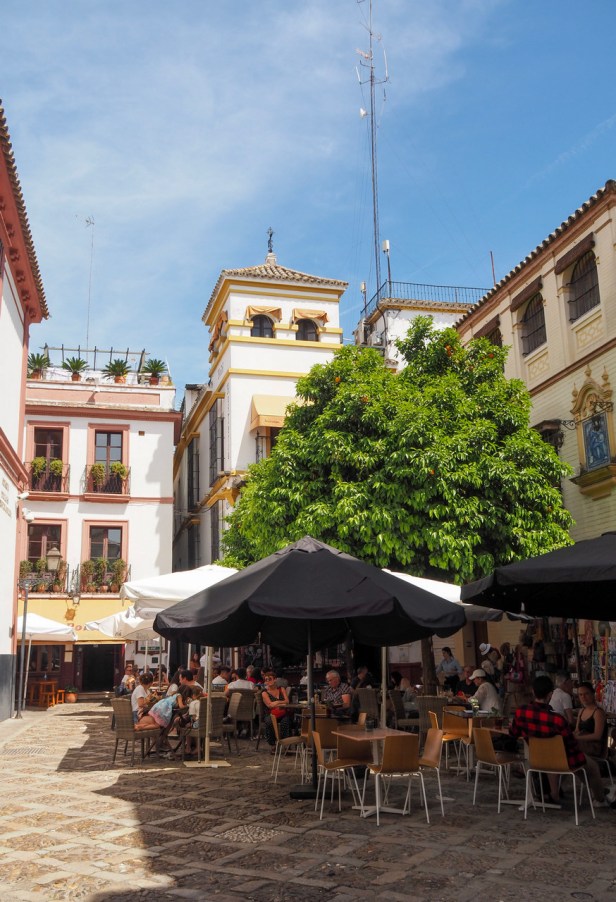
While a significant remodelling of Barrio de Santa Cruz took place in occasion of the 1929 world exposition hosted in Sevilla, today the quarter still spots several historic sites. Indeed, this beautiful labyrinth of narrow winding streets, whitewashed houses, and flowery courtyards and balconies make you feel like being transported right back to medieval times.
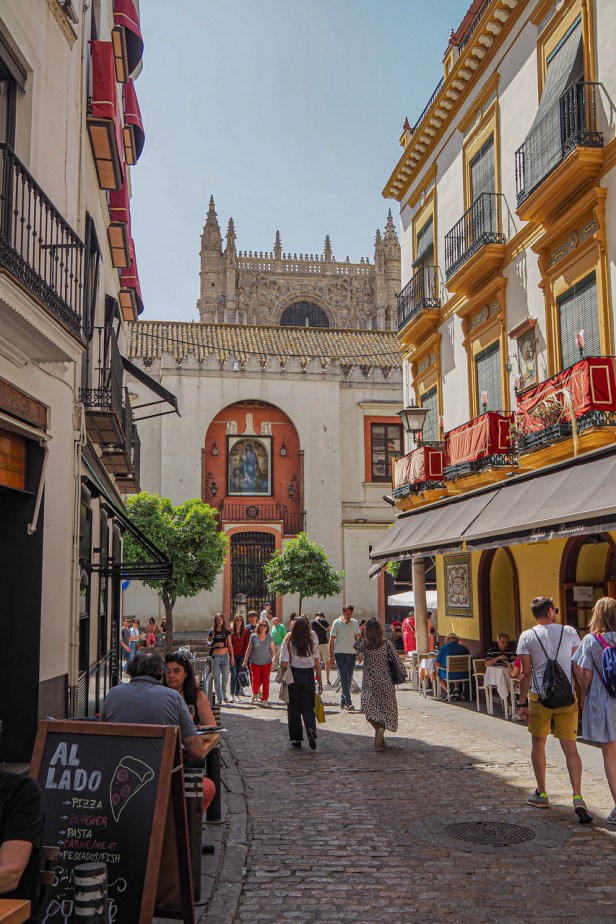
To learn more about Barrio de Santa Cruz check out my post Exploring Barrio de Santa Cruz: The historic heart of Sevilla.
Casa de Pilatos
Located at the northern edge of Barrio de Santa Cruz, the beautiful Casa de Pilatos is another gem of the old quarter. The historic home of Don Pedro Enriquez and later his son Fadrique Enriques de Ribera is still partly inhabited by the 18th Duchess of Medinacelli and her family. Named after the house of Pontius Pilate, it is one of the best-preserved houses from the 16th century.

While build in the typical Mudéjar style of historic Sevilla, Case de Pilatos also includes elements of Italian Renaissance. Its stunning centrepiece is the large patio with a well and fountain surrounded by arches spotting 24 busts of Roman emperors and Greek gods while the walls along the corridor are adorned with the stunning colourful azulejos of Sevilla. There is also a beautiful small garden in Italian style.
Metropol Parasol
While it’s the city’s historics monuments, lively cultury and excellent food that make a visit to Sevilla particularly worthwhile, the stunning modern Metorpol Parasol is a construction not to be missed.

Sitting just at the edge to the historic part of the city, on Plaza de la Encarnación, Setas of Sevilla (also referred to as Mushrooms of Sevilla) is an amazing recently built viewing platform. It is the largest wooden structure in the world, designed by architect Jürgen Mayer.

Completed in 2011 as part of a revitalization of the large square, the structure offers amazing views over Sevilla and its surrounding landscape on a 360 degree radius.
Integrated into the Metropol Parasol is an archaeological museum showing the remains of a historic Roman colony including mosaics and houses from the first century AD.

While on-site, definitely take some time to explore Mercado de Encarnación, one of Sevilla’s fantastic farmers markets boasting close to 40 stalls with the best fresh food, from seafood and fish to fresh fruits and vegetables, cheeses, charcuterie and meats.
Torre del Oro
Located right next to the Guadalquivir River, Torre del Oro (the golden tower) was built in the 12th century by the Almohad Caliphate as part of the Moorish city wall to control shipping on the river.

The name officially refers to the city’s most prosperous period at the hights of the Spanish Latin American colonies when Sevilla was the main port of call for ships discharging cargo – including gold – from the colonies. However, the tower also appears to shine a golden reflection in the river and today when it’s lit during the night there is an apparent golden touch.
A small maritime museum is located at the top floor of the tower with antique shipping instruments, scale models and sea maps on display.
Plaza de Torros
Definitely not on my list of things to do when visiting Sevilla was going to a bull fight – for all the obvious reasons. Yet I can only recommend a visit to Plaza de Torros for the stunning building itself.

Officially called La Maestranza de Sevilla, the bull arena features a unique Baroque facade dating from 1762-1881 and is certainly one of the most beautiful buildings in the city.
Mercado Lonja del Barranco
Also located right next to Guadalquivir River next to Puente Isabel II, the former fish market Mercado Lonja del Barranco was turned into a foodie heaven. Different from many of the historic food markets found all over Spain, this one is rather modern and upscale. Instead of the traditional food stalls selling fresh produce, at Mercado Lonja you will mostly find small shops and stalls selling prepared foods and drinks.

In fact, the place will fill up with locals and tourists alike around midday for a quick lunch. If you come early enough, you might be lucky to catch a table on the patio overlooking the river.
Puente Isabel II
The oldest bridge in Sevilla was build following the design of the later demolished Carrousel Bridge in Paris, which was originally built in 1834 by French engineer Polonceau.

Prior to the opening of Isabell II bridge in 1852, crossing the Guadalquivir River into Triana neighbourhood was not at all easy. It took until the end of the 12th century, for the first bridge to be constructed by the Almohads right where Ponte Isabel II sits today. Nevertheless, crossing the river remained difficult considering the bridge was set up by boats tied one after the other, and thus rather unstable and precarious to cross.
Triana neighbourhood, the home of Sevilla’s azulejos and birthplace of Flamenco
Despite a growing popularity, this amazing historic neighbourhood is still largely overlooked by visitors. While Triana is not boasting such striking historic monuments like Real Alcazar or Sevilla’s cathedral, the quarter’s rich cultural history, authenticity, and the overall laid-back atmosphere along with several historic sights makes this laidback and lively barrio a real highlight of the city.

If you want to know more about Barrio de Triana and what to do and see when visiting, check out my post Here is why you should explore Triana neighbourhood in Sevilla, Spain.
Visiting a traditional Flamenco show
Sevilla, and more precisely Barrio de Triana on the other side of the Guadalquivir River is the birthplace of Flamenco. Thus, when visiting, make sure to seek out one of the many Flamenco bars.
Some of the best will be indeed located at Triana neighbourhood. Either head to Teatro Flamenco Triana, located in Calle Pureza, or head to one of the many small local flamenco bars offering a more intimate and authentic experience. Many of those smaller places, including El Rejoneo and Lo Nuestro on Calle Betis, La Taberna in Calle Duarte or Casa Anselma in Calle Pagés del Corro do not require you to pay for the flamenco performance, while the hosts will make sure you order at least a couple of drinks.
Go on a tapas crawl
There are so many tapas bars in Sevilla, it’s hard to decide where to start. The good news is, even the most touristy place will likely have a decent selection of nice tasting tapas on the menu.
That said, the top Sevilla tapas bars regularly include El Rinconcillo, said to be the oldest tapas bar in the city. Opened in 1670, the restaurant not only offers excellent tapas but also other traditional Andalucian food and a long wine list.

Then there is also one of my favourites: ENA Sevilla, located at the iconic Hotel Alfonso XIII during the warmer months (thus during large parts of the year) offers a fantastic selection of tapas to be enjoyed on the large terrace overlooking Puerta de Jerez square.
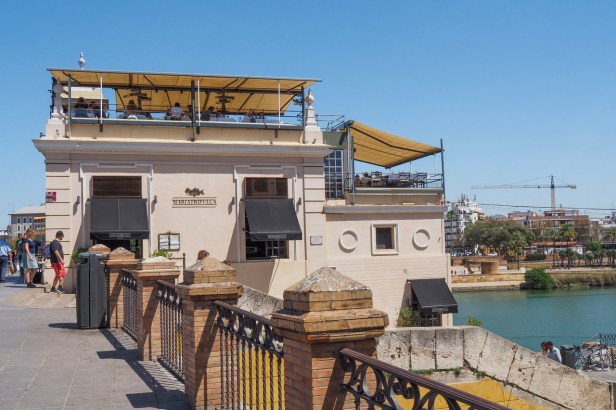
Another excellent place that offers tapas but also other food is Mariatrifulca restaurant. Located right at the end of Puente Isabel II at the entrance to Triana neighbourhood, the restaurant not only offers excellent food. The view from the rooftop terrace overlooking the river, Real Maestranza, Torre d’Oro and the Giralda.
Are you planning a trip to Sevilla, in Spain? Let me know if you found this guide helpful.
